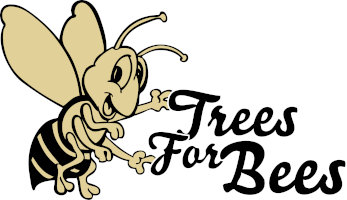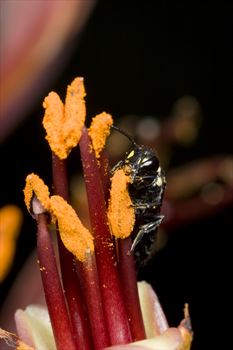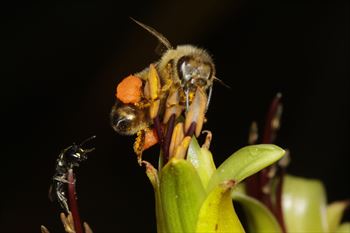

Figure 3a. The native masked bee (Hylaeus sp.) ‘eating’ the pollen from a native New Zealand Flax flower in Waikato. Photo: Neil Fitzgerald ©Trees for Bees NZ.

Figure 1. Native New Zealand Flax: Phormium tenax from Sealers Creek in Auckland Island. Anthers protrude from the top of the tubular flower. The honey bee has large orange flax pollen pellets on hind legs. Photo: Finn Scheele ©Trees for Bees NZ

Figure 2. Flower of New Zealand flax from Sealers Creek in Auckland Island. The honey bee is taking nectar at the top of the tubular flower which is filled to the brim with nectar. If the nectar level is high enough, the bee’s tongue (7 mm) can reach it. Photo: Finn Scheele ©Trees for Bees NZ.

Figure 3b. Flower of an ornamental New Zealand flax at Hicks Bay, East Cape. The honey bee is collecting pollen while the small native masked bee (Hylaeus sp.) waits its turn on the left-hand side of the photo. Photo: Jules Boileau © Trees for Bees NZ.
Star Performer Status
New Zealand flax is a star performer because it has the highest protein that we have measured in pollen (ca. 35% to 45%) and plenty of pollen is produced in each flower. Flax flowers in late spring to summer (anytime from September to January), which can conflict with or complement the honey flow season.
Introduction
We worked with two species, Phormium tenax and Phormium cookianum in the National New Zealand Flax Collection at Landcare Research, Lincoln. We collected at several sites in East Coast/Gisborne as well. In the Flax Collection you can see a great range in height and number of flowering stalks and size of leaves. Flowers are usually red but some varieties have yellow or greenish petals.
Pollen
Pollen
Access to pollen is easy for bees because each flower has six large anthers that protrude well beyond the top of the floral tube. Honey bees always mix the pollen with nectar to form large pollen pellets in their pollen baskets (Figure 1), but native bees (Leioproctus spp. and Lasioglossum spp.) pack their hairy back legs with dry pollen without nectar. In contrast, another type of native bee, the masked bee (Hylaeus spp.) consumes the pollen to store in its crop (Figure 3a). This pollen is then regurgitated in the nest to make a ball of pollen to provision the fertilised egg, which will emerge as a bee the following spring. Competition for pollen between native and honey bees can be observed when bee densities are very high (as shown in Figure 3b).
The pollen in one flax flower weighs on average about 5 mg (range from 2 to 9 mg depending on the variety). Some large prolific varieties of flax can produce over 2000 flowers per season but small varieties with few stems produce only a few hundred. Since one bee needs from 120 to 140 mg of pollen to grow from egg to adult, then one single large plant with 10 to 20 stems can support from 70 to 80 bees (for example, the Gold Edge variety from Three Kings Island), but a small plant with limited stems will support fewer bees.
Nectar
Nectar New Zealand flax flowers produce bountiful nectar (ca. 100 μl) which sometimes fills the floral tube to the brim. Even honey bees with their short tongues can access nectar at the top of the tube (see Figure 2, next page). But the floral tube is too narrow and filled with stamens for honey bees to crawl very far into the flower if the nectar level is too low.
When the nectar is drained to a level below their reach, honey bees will sometimes access a little nectar at the base of the floral tube by inserting their tongue in between the petals. Honey bees are competing with nectar-loving birds like tui. If the birds take the nectar first, the honey bees will lose out because the nectar level in the tube will too low for the honey bee to reach directly.
Planting Advice
Planting advice
New Zealand flaxes are widely used in Trees for Bees demonstration farms, primarily in riparian zone planting, but also as part of land stabilisation planting and wet areas, as excellent low shelter in shelterbelts, and as part of mixed native and exotic species plantings. It is a unique native plant used for weaving, cordage, landscaping and wetland restoration. For more information, go to http://www.landcareresearch.co.nz/science/ plants-animals-fungi/plants/ethnobotany/ weaving-plants/information-sheets/harakekeand- wharariki.
As noted earlier, the main species that we have used to date have been the common New Zealand flax (Phormium tenax) and the mountain flax (Phormium cookianum), with a wide number of varieties that can be used. It is important that the flaxes you plant flower as expected, especially the more cultivated forms. Phormium tenax grows quite large in time (up to 5–6m), and so it may not be suited where space is limited. In these situations, Phormium cookianum can work well as it only grows to about 2m, and can have narrower and more pendulous leaves, giving a softer appearance.
As flaxes typically flower between September and January, this can cause overlap with pollination services and honey harvesting, which needs to be considered in your planting plans. Early settlers in New Zealand complained about flax nectar contaminating their clover honey as these can flower simultaneously. While flax can flower at the same time as mānuka, it could be an important pollen source since honey bees do not take mānuka pollen and need another pollen source at this time.
Where planting along watercourses, it is important to ensure that the flaxes aren’t so close as to impede water flow in flood events. While the flaxes will tolerate being submerged underwater, larger plants can impede water flow, leading to damming and further flooding. It is best to establish grasses such as Carex secta adjacent to but still above the normal water flow level, with flaxes located further away from the stream margin and out of the flood zone if possible.
Another issue with flaxes is that they can provide attractive nesting sites for rats when planted close together in groups. If this is an issue in your area, spread your flax plants out so that they don’t provide nesting sites around their base.
With good planning and selection of the best varieties and convenient flowering times for your goals, flax can give a big boost to your bees because of their highly nutritious and abundant pollen.
What did Walsh (1967) 1978 say?
Flax (Phormium tenax).
Its dull reddish flowers are borne in large panicles regularly spaced on 2 m to 3 m long flower stem and are in bloom from late October to January.
The blossoms secrete a great quantity of pale clear nectar. The structure of the flower prevents the bees entering the narrow corolla, but they overcome this difficulty by inserting their tongues where the petals overlap.
Flax honey is medium to dark amber in colour, of poor flavour and coarse grain. Fortunately a heavy flow from this source is experienced only every third or fourth year.
The bees have been observed working flax at 5.30 a.m. This plant is a good source of deep salmon pollen in all seasons.
Quoted from Page 25 in the book Nectar and Pollen Sources of New Zealand by R.S. Walsh first published in 1967 and second edition in 1978 edited by Trevor Walton with assistance from David Williams, Rotorua.
Exotic
False
Native
True